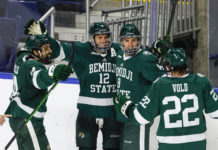You may have heard the criticism of the USA Hockey National Team Development Program at some point. In short, it goes like this:
Too much money on too few players.
I’m guessing you’d get a “bring it on” kind of look from a pro-NTDP person today if you tried to start the argument.
The majority of the United States team that beat Canada for the World Junior Championship title Tuesday night went through the NTDP in Ann Arbor, Mich.
The most defensive of the program should concede that not all of the skills those 12 players took to Saskatoon was a result of their time in Ann Arbor, but the most enthusiastic detractors probably should admit that some good was done there in relation to this year’s U.S. World Junior team.
Wisconsin coach Mike Eaves led the U.S. to its only other WJC gold, in 2004, was a coach at the NTDP before joining the Badgers, and his team plays the Under-18 Team on Saturday. So it seemed like a good time to ask about the program. Here’s what he had to say:
“There’s an ongoing debate, and it’s very passionate. You’re right about the statement that it’s a lot of money for a few amount of kids, but the fact is it worked. Those kids went there, they played up, they got great coaching, great training, played against tough competition, and were able to compete and win on the world level. What’s going on now with the USA Hockey, they’ve got a development program that they’re trying to implement now. So we’re almost flipping the pyramid upside down. We’ve gone to the top and worked with and spent a lot, and now they’re trying to tip it upside down, work on the base, and then create it so it will go up.
“So I’m talking out of both sides of my mouth, but the fact is they did something. They took action, they made a stand, they made it work, it’s been successful. Now they’re trying to get to the masses, and the argument of, well, why didn’t we do that in the first place? Well, I don’t know the answer to that. But the fact is, the program was successful, now they’re looking at broad-basing it, building it from the ground up, which hopefully, you would think that in the long run it’s going to create a broader base of talent. They’re going to try to do the right things with these young people, focus on skills, focus on practice, fewer games.
“This is going to be a tough sell in this country, because to a large degree parents want to see their kids play. They don’t want them to practice. They want to see them play. And yet you don’t get that much better in games because you don’t have the puck at all. It’s in practices. It’s this 10,000-hour theory of just getting on the pond and playing. It’s been interesting watching the outdoor game, and they got documentaries on pond hockey. This is where we used to learn the game, not with one 60-minute practice, but by just going out and playing.
“So that’s a long-winded answer, but the fact is I think we’re trying to get to do the right things, but this program that they started in Ann Arbor was successful.”
I’m not sure the argument will every completely die, but the scale may be tipping for the moment.
